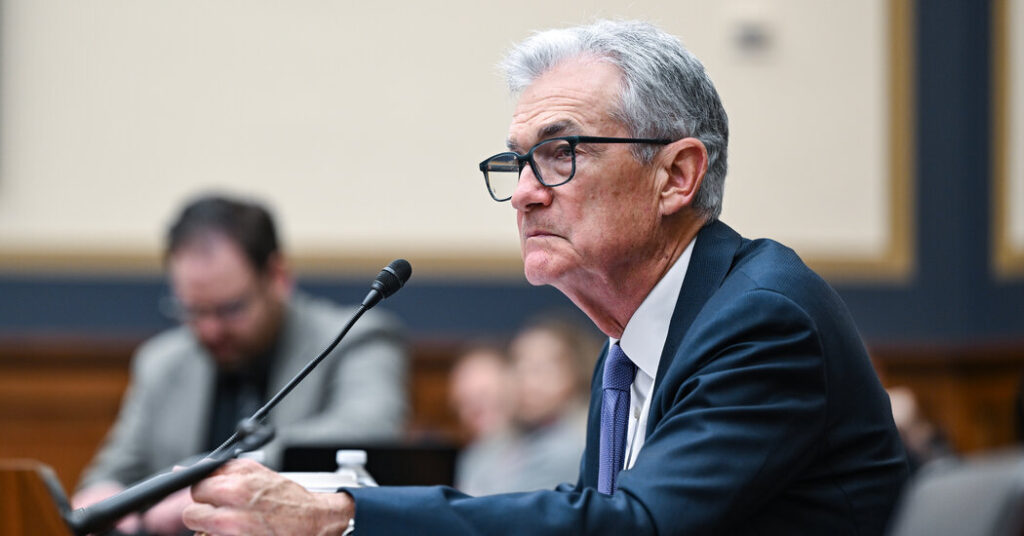Jerome H. Powell, the chair of the Federal Reserve, indicated on Tuesday that recent inflation data had given the central bank more confidence that price increases were returning to normal, and that continued progress along these lines would help to pave the way toward a central bank rate cut.
“The Committee has stated that we do not expect it will be appropriate to reduce the target range for the federal funds rate until we have gained greater confidence that inflation is moving sustainably toward 2 percent,” Mr. Powell said.
He added that data earlier this year failed to provide such confidence, but that recent inflation readings “have shown some modest further progress, and more good data would strengthen our confidence that inflation is moving sustainably toward 2 percent.”
Mr. Powell delivered the remarks on Tuesday in an appearance before the Senate Banking Committee. While Mr. Powell avoided zeroing in on a specific month for when the Fed might begin to cut interest rates, he also did little to push back on growing expectations that a reduction could come in September. Fed officials meet in late July, but few economists expect a move that early.
The chair’s congressional testimony came at a delicate moment for the central bank. Fed officials are trying to figure out when to begin cutting interest rates, which they have held at the highest rate in decades for roughly a year now. But as they weigh that choice, they must strike a careful balance: They want to keep borrowing costs high long enough to cool the economy and fully stamp out rapid inflation, but they also want to avoid overdoing it, which could crash the economy too much and cause a recession.
“If we loosen policy too late or too little, we could hurt economic activity,” Mr. Powell said. “If we loosen policy too much or too soon, then we could undermine the progress on inflation. So we’re very much balancing those two risks, and that’s really the essence of what we’re thinking about these days.”
While Fed officials spent 2022 and much of 2023 focused on beating back inflation, even if that came at an economic cost, price increases have cooled enough that they are now clearly taking the trade-offs between cooling inflation and weakening the labor market into account.
After jumping to 9.1 percent in 2022, Consumer Price Index inflation is expected to fade to 3.1 percent as of a June reading set for release this Thursday. Importantly, prices are now climbing very slowly on a monthly basis, a sign that inflation is coming back under control.
“After a lack of progress toward our 2 percent inflation objective in the early part of this year, the most recent monthly readings have shown modest further progress,” Mr. Powell said.
The inflation slowdown has come in part because supply chains have healed from pandemic-related disruptions, allowing goods prices to fall. But the progress also owes to a continued cooling in the broader economy.
That moderation in economic growth ties back to Fed policy. Starting in March 2022, central bankers raised interest rates rapidly to their current 5.3 percent before leaving them on hold at that elevated level. That has made it expensive to borrow to expand a business, to buy a car or to purchase a house — tamping down economic demand.
The job market is also slowing after years of surprising strength. Job openings have been gradually coming down after spiking following pandemic lockdowns, and the unemployment rate has been ticking steadily higher. Wage growth is also pulling back, a sign that employers aren’t paying up as much to compete for new hires.
“In the labor market, a broad set of indicators suggests that conditions have returned to about where they stood on the eve of the pandemic: strong, but not overheated,” Mr. Powell said.
Altogether, Mr. Powell’s comments painted a picture of an economy that was moving toward the Fed’s goals gradually, potentially allowing for the gentle comedown that central bankers had been hoping to achieve. While it is rare for the Fed to crush serious inflation without causing a recession, officials have been optimistic that they might manage to pull it off in this episode.
Mr. Powell also fielded questions about a major Fed bank regulation proposal, called “Basel III Endgame,” which has stoked disagreement among regulators and drawn outcry from banks and their lobbyists. Fed officials have been clear that they plan to make major changes to the proposal, and banking groups want regulators to entirely re-propose it.
“It is the strongly-held view of members of the Board that we do need to put a revised proposal out for comment for some period,” Mr. Powell said, later suggesting that the new comment period might be something like 60 days.
“We’re working through that question with” other regulators, he said. “We’re prepared to move forward when we do reach agreement on that.”
He also faced questions about the housing market, which is struggling with a shortage of inventory. Some lawmakers have blamed the Fed for that: Because mortgage rates have gone up so much with higher Fed interest rates, many people are avoiding moving, choosing to stay put and hold onto their low fixed rates. Home building has also pulled back.
“For housing supply, the best thing that we can do is get inflation under control so that rates can come back down,” Mr. Powell said. “Policies to increase housing supply are really not so much in the hands of the Fed they’re in the hands of legislatures, state and federal.”
Mr. Powell will testify on Wednesday before the House Financial Services Committee.


